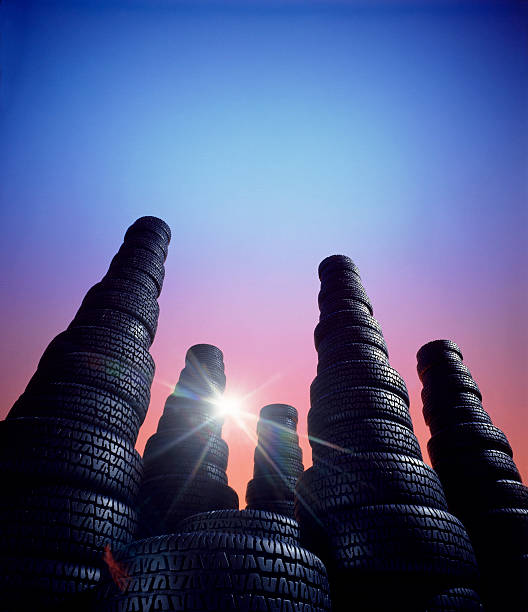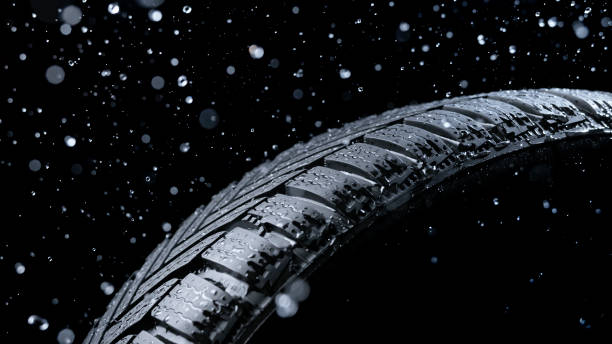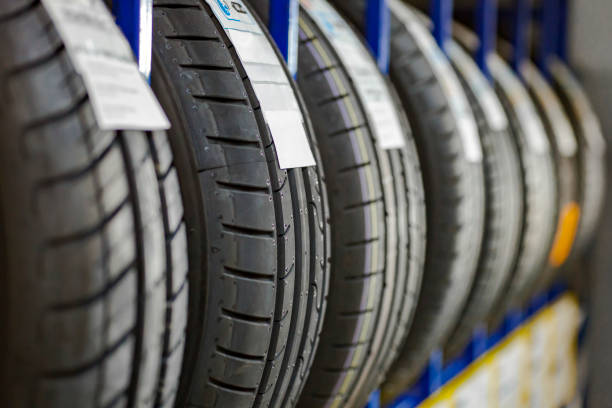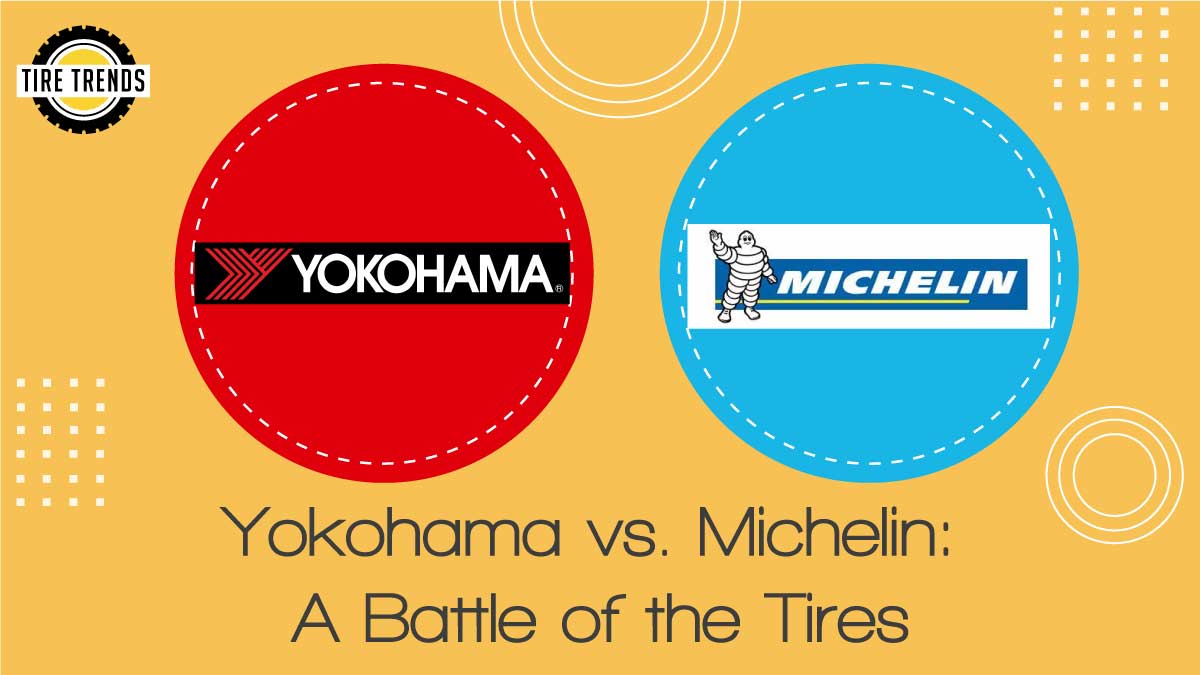When it comes to ensuring a smooth and safe ride for your vehicle, the tires you select play a pivotal role. Two major players in the tire industry, Yokohama and Michelin, have garnered a reputation for their exceptional tire offerings.
In this article, we will delve into the intricate details of these tire giants, comparing their performance, durability, eco-friendliness, and overall value proposition. Buckle up as we embark on this journey to uncover the nuances of the Yokohama vs Michelin rivalry.
Company Background and Tire Lineup

Both Yokohama and Michelin boast rich histories in the tire manufacturing realm. Let’s take a closer look at what each brings to the table:
Yokohama
- Founded in 1917, Yokohama has traversed decades of innovation and expertise.
- They have evolved to offer an extensive lineup that caters to various vehicle types, ranging from sedans to SUVs.
- Their commitment to diversity ensures that they have a tire to suit almost every driving need.
Michelin
- With a legacy dating back to 1889, Michelin has etched its name as a global tire juggernaut.
- Michelin’s product range includes a diverse array of tire models designed to deliver optimal performance on a variety of road surfaces.
- Their tire lineup is a testament to their dedication to providing solutions that cater to different driving scenarios.
Performance Metrics Comparison
Tread Design and Pattern
Yokohama Performance Metrics
- Yokohama’s tires stand out with their innovative tread patterns that enhance grip and effectively channel water.
- Their utilisation of “Tri-Blend Compound” technology contributes to a balanced performance on both wet and dry surfaces.
Michelin Performance Metrics
- Michelin takes a data-driven approach to optimise their tread designs, using computer simulations and real-world testing to achieve the best results.
- The inclusion of the “Helio Compound” in their tires ensures flexibility at low temperatures, ultimately improving winter performance.
Dry Surface Grip
Yokohama Dry Surface Grip:
- When it comes to exceptional dry traction, Yokohama’s “ADVAN Sport” models shine brightly due to their specialized rubber compounds.
- They employ asymmetric tread patterns that ensure better road contact during acceleration and braking, enhancing overall performance.
Michelin Dry Surface Grip:
- Michelin’s “Pilot Sport” series has earned a reputation for its remarkable dry grip capabilities, which are made possible through the use of high-density silica compounds.
- Their “Bi-Compound” technology is designed to optimise grip during cornering while maintaining stability at high speeds.
Wet Surface Handling

Yokohama Wet Surface Handling:
- Yokohama’s commitment to wet surface performance is evident through its “Circumferential Groove” technology, which effectively enhances water dispersion and reduces the risk of hydroplaning.
- The inclusion of “Cross-Linked Silica” compounds in their tires contributes to improved wet traction, ensuring a safer driving experience in wet conditions.
Michelin Wet Surface Handling:
- Michelin’s dedication to wet surface handling is reflected in their “HydroEdge” technology, which efficiently channels water away from the tire’s contact patch, maintaining optimal road contact.
- Their “Green X” series focuses on achieving exceptional wet grip without compromising on fuel efficiency, addressing both safety and eco-consciousness.
Cornering Stability
Yokohama Cornering Stability:
- Yokohama’s tires often stand out for their cornering stability, thanks to features such as reinforced sidewalls and stiffer construction.
- Their “Solid Center Rib” designs contribute to responsive steering and enhanced stability during turns, making for a confident driving experience.
Michelin Cornering Stability:
- Michelin employs their “Variable Contact Patch 2.0” technology to optimise pressure distribution during cornering, ensuring consistent and balanced performance.
- Enhanced lateral grip and sidewall rigidity further contribute to Michelin’s reputation for confident cornering performance.
Check out our article on the Michelin vs Continental Tires.
Durability and Longevity
Tread Life Expectancy
Yokohama Tread Life Expectancy:
- Yokohama’s “BluEarth” tires are designed with a focus on long-lasting tread life, achieved through the use of durable compounds.
- The incorporation of “Orange Oil” technology enhances wear resistance while also maintaining fuel efficiency, striking a balance between performance and economy.
Michelin Tread Life Expectancy:
- Michelin’s commitment to longevity is evident in their “EverGrip” technology, which ensures consistent tread depth throughout the tire’s lifespan.
- Proprietary rubber compounds used by Michelin help reduce wear, ultimately translating to increased mileage and extended tire life.
Mileage Warranty

Yokohama Mileage Warranty:
- Yokohama’s dedication to customer satisfaction extends to their mileage warranties, which range from 50,000 to 70,000 miles, varying by specific tire models.
- As with any warranty, understanding the terms and conditions is essential to make the most of the coverage provided.
Michelin Mileage Warranty:
- Michelin’s “Promise Plan” includes mileage warranties on select tire models, providing customers with added peace of mind when it comes to their investment.
- The specific coverage offered varies depending on the tire model, making it important to review the details to ensure alignment with your needs.
Resilience to Road Hazards
Yokohama Resilience to Road Hazards:
- Yokohama’s “Tuff Duty” technology is designed to enhance puncture resistance and overall durability.
- Robust sidewalls, a hallmark of Yokohama’s tire design, play a key role in mitigating damage from common road hazards.
Michelin Resilience to Road Hazards:
- Michelin’s “MaxTouch Construction” prioritises even wear distribution, which helps extend the life of the tire while also managing road forces effectively.
- Sidewall reinforcements, another key feature in Michelin’s design philosophy, contribute to the tire’s resilience against road hazards.
Eco-Friendly and Fuel Efficiency
Sustainable Materials
Yokohama Sustainable Materials:
- Yokohama’s emphasis on sustainability is evident in their tire manufacturing process, where they incorporate environmentally friendly materials.
- Their commitment to reducing the carbon footprint during tire production aligns with a broader effort to make a positive impact on the environment.
Michelin Sustainable Materials:
- Michelin’s dedication to sustainability is reflected in its choice of eco-friendly materials during tire production.
- By actively working to reduce energy consumption throughout its manufacturing process, Michelin contributes to the preservation of the environment.
If you have a problem then you can find the solution of Foam Filling Skid Steer Tires.
Rolling Resistance
Yokohama Rolling Resistance:
- Yokohama’s focus on low rolling resistance technology not only contributes to better fuel efficiency but also enhances overall performance.
- Tire models like the “ADVAN dB” series are designed to minimise energy loss during driving, translating to cost savings at the fuel pump.
Michelin Rolling Resistance:
- Michelin’s “EnergySaver” technology is geared toward reducing rolling resistance, which in turn leads to improved fuel economy for the vehicle.
- Tires labelled with Michelin’s “Green X” designation offer the dual benefit of fuel efficiency and traction, catering to both performance and eco-conscious drivers.
User Reviews and Real-World Testing
When it comes to making informed decisions about tires, user reviews and real-world testing play a crucial role. Here’s how they provide insights:
- User Reviews: Customers who have experienced Yokohama and Michelin tires firsthand often share their experiences through online reviews. These reviews can offer valuable insights into various aspects of the tires, including performance, durability, road noise, and overall satisfaction. Reading through a variety of user reviews can help you gauge the general consensus regarding each brand’s tire offerings.
- Independent Testing: Independent tire comparison tests are conducted by organisations and publications with a focus on providing unbiased data. These tests involve putting different tire models through a series of rigorous evaluations, including wet and dry surface handling, cornering stability, braking performance, and more. The results of these tests offer a data-driven perspective on how Yokohama and Michelin tires perform in real-world scenarios, helping consumers make informed choices based on objective findings.
- Customer Satisfaction Ratings: Organizations often compile customer satisfaction ratings based on surveys and feedback from tire owners. These ratings encompass various aspects such as performance, durability, value for money, and overall customer experience. Analysing these ratings can give you a broad understanding of how Yokohama and Michelin’s tires are perceived by their users and whether they meet or exceed expectations.
Pricing and Value Proposition
The cost of tires is a significant consideration for many consumers. Understanding the pricing structure and the value each brand offers is essential. Here’s what to keep in mind:
Yokohama:
- Yokohama’s pricing strategy is diverse, with variations based on tire models and intended applications. This allows consumers to choose tires that align with their specific driving needs and budget.
- While price is a factor, it’s important to consider the overall value proposition. Evaluate how the tire’s performance, durability, and other features align with the price point to ensure you’re getting the best value for your investment.
Michelin:
- Michelin’s premium reputation often leads to a slightly higher price range for their tires. This premium is reflective of the technology, research, and development that goes into crafting high-quality tires that deliver superior performance and longevity.
- When assessing Michelin’s offerings, consider the unique features they bring to the table. Features such as advanced tread designs, innovative rubber compounds, and technologies for enhanced grip and stability justify the premium pricing for many consumers.
FAQ Section
How do Yokohama’s all-season tires perform in snowy conditions?
Yokohama’s all-season tires often come with snow traction features, but for severe snow conditions, dedicated winter tires are recommended.
Are there any Michelin models specifically designed for high-performance sports cars?
Michelin’s “Pilot Sport” lineup includes tire models tailored to sports cars, offering impressive grip and responsive handling.
What is the typical lifespan of Yokohama’s eco-friendly tires compared to conventional tires?
Yokohama’s eco-friendly tires tend to have a comparable lifespan to conventional tires of similar quality.
Do either Yokohama or Michelin offer specialised tires for off-road adventures?
Both Yokohama and Michelin offer tire models designed for off-road use, featuring characteristics like reinforced sidewalls and aggressive tread patterns.
Are there any Michelin run-flat tire options available, and how do they compare to Yokohama’s offerings?
Michelin does offer run-flat tires that allow limited driving after a puncture. Yokohama also offers run-flat models, but specific performance comparisons may vary.
Can I mix and match Yokohama and Michelin tires on my vehicle for better performance?
It’s generally recommended to maintain uniform tire brands and models on your vehicle to ensure consistent performance and handling.
Do either of these manufacturers provide any road hazard protection or warranty?
Both Yokohama and Michelin offer varying levels of road hazard protection and warranty coverage. Reviewing specific details for each tire model is essential.
Are there any significant differences in noise levels between Yokohama and Michelin tires?
Noise levels can vary among different tire models. Both Yokohama and Michelin have models designed to minimise road noise, offering a quieter driving experience.
Conclusion
As we conclude the Yokohama vs Michelin tire showdown, it’s evident that both companies excel in their own unique ways, catering to diverse driving preferences and needs. By delving into the intricate performance metrics, durability factors, eco-friendliness attributes, and pricing considerations, you can make an informed decision that aligns seamlessly with your vehicle and driving style.
Whether your focus is on exceptional dry grip, longevity, or eco-consciousness, the ultimate choice between Yokohama and Michelin hinges on what best suits your distinct requirements. So, as you navigate the world of tires, keep these insights in mind to ensure a safe, efficient, and satisfying driving experience.

